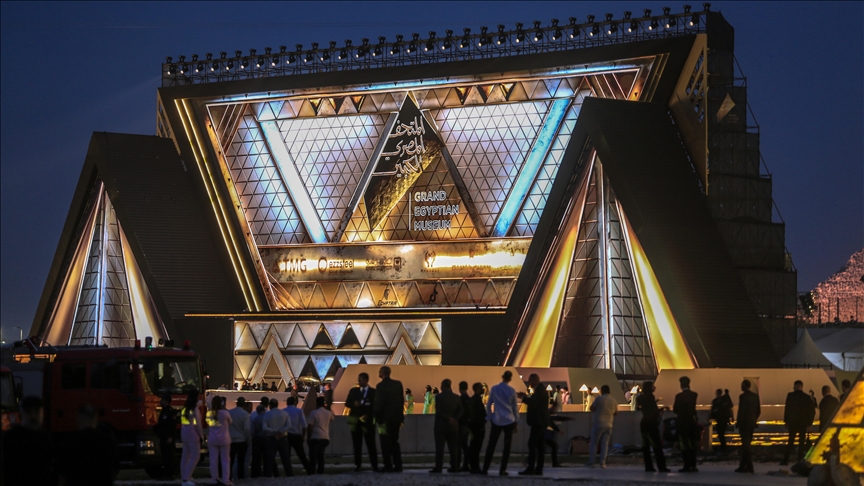Egypt opens vast museum by the Pyramids dedicated to ancient civilization
Grand Egyptian Museum costs around $1 billion, houses over 57,000 artifacts chronicling Egypt’s history
 A view of The Grand Egyptian Museum, built near the Giza Pyramids, as it is set to open on November 01, 2025 in Giza, Egypt. The museum, which has been under construction for more than two decades and is the largest archaeological museum in the world, will allow visitors to view the complete treasure of Pharaoh Tutankhamun in one place.
A view of The Grand Egyptian Museum, built near the Giza Pyramids, as it is set to open on November 01, 2025 in Giza, Egypt. The museum, which has been under construction for more than two decades and is the largest archaeological museum in the world, will allow visitors to view the complete treasure of Pharaoh Tutankhamun in one place.
CAIRO / ISTANBUL
After years of anticipation, the Grand Egyptian Museum by the Pyramids opened on Saturday evening, marking the world’s largest archaeological complex dedicated to a single civilization.
The museum was opened in an official ceremony attended by President Abdel Fattah al-Sisi and delegations from 79 countries, including 39 led by kings, princes, and heads of state and government.
The launch featured musical performances in one of the museum’s courtyards, with the three pyramids visible in the background.
Performers appeared in distinctive pharaonic attire, resembling a grand procession.
Egyptian Prime Minister Mostafa Madbouly described the museum as a “unique global edifice” and an “exceptional event in Egypt’s history.”
“This dream has lived in our imagination for years. This world-class monument is a gift from Egypt to humanity -- a nation with more than 7,000 years of history,” he told a press conference before the opening.
Madbouly thanked everyone who contributed from the idea’s inception to the completion of the project, noting that most of the construction was carried out over the past seven years.
He explained that the concept dated back around 30 years, followed by preparatory work, design competitions, and architectural studies, before the construction began.
Board of Trustees member and businessman Mohamed Mansour predicted that the museum would attract over five million visitors annually.
‘Fourth pyramid’
The idea of the Grand Egyptian Museum originated in the 1990s under former Culture Minister Farouk Hosni, who envisioned an open museum encompassing the pyramids, the Sphinx, and surrounding temples.
Former President Hosni Mubarak laid the foundation stone for the museum in 2002, and site preparation began in May 2005, but the project stalled for years.
Work resumed in 2014 under President Sisi, who expanded the plan to make it the largest museum in human history.
Between 2017 and 2023, construction, digital infrastructure, display design, and service and investment facilities were completed. The museum began trial operations in October 2024, pending its official opening as the world’s largest archaeological complex dedicated to a single civilization -- Ancient Egypt.
Located two kilometers from the Giza Pyramids, the museum covers 490,000 square meters. Visitors can view the pyramids through the five-story glass facade, designed to align with the Great Pyramid’s height, and take photos with the pyramids while exploring King Tutankhamun’s treasures.
The project cost around $1 billion, financed through two Japanese loans totaling $800 million, in addition to Egyptian government funding, donations, and partnerships.
The entrance hall features a colossal statue of Ramses II, and the museum houses over 57,000 artifacts chronicling Egypt’s history. The Grand Staircase spans 6,000 m² -- the height of a six-story building -- and the museum includes 12 main galleries, temporary exhibition halls, and the Tutankhamun collection with over 5,000 artifacts displayed together for the first time since the tomb’s 1922 discovery.
It also includes a children’s museum, artifacts from Queen Hetepheres, mother of King Khufu, the Khufu boat museum, and various pieces from the Greek and Roman eras.
The design represents sun rays converging from the three pyramids, forming a conical structure -- the museum itself -- appearing as a “fourth pyramid” when viewed from above.
The logo, unveiled on June 10, 2018, emerged from an international UNESCO-supervised design competition. It reflects the building’s architectural identity, inspired by the orange glow of sunset over the plateau and fluid Arabic calligraphy evoking desert dunes.
Anadolu Agency website contains only a portion of the news stories offered to subscribers in the AA News Broadcasting System (HAS), and in summarized form. Please contact us for subscription options.







